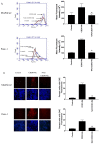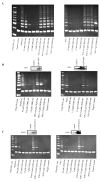Inhibition of telomerase activity by oleanane triterpenoid CDDO-Me in pancreatic cancer cells is ROS-dependent
- PMID: 23486104
- PMCID: PMC3632053
- DOI: 10.3390/molecules18033250
Inhibition of telomerase activity by oleanane triterpenoid CDDO-Me in pancreatic cancer cells is ROS-dependent
Abstract
Methyl-2-cyano-3,12-dioxooleana-1,9(11)-dien-28-oate (CDDO-Me) is a synthetic derivative of oleanolic acid, a triterpene, with apoptosis-inducing activity in a wide range of cancer cells. Induction of apoptosis by CDDO-Me is associated with the generation of reactive oxygen species (ROS) and inhibition of telomerase activity. In the present study, we investigated the role of ROS in inhibition of telomerase by CDDO-me. Treatment of MiaPaCa-2 and Panc-1 pancreatic cancer cell lines with CDDO-Me induced the production of hydrogen peroxide and superoxide anions and inhibited the telomerase activity. Pretreatment of cells with N-acetylcycsteine, a general purpose antioxidant or overexpression of glutathione peroxidase (GPx) or superoxide dismutase-1 (SOD-1) blocked the telomerase inhibitory activity of CDDO-Me. Furthermore, blocking ROS generation also prevented the inhibition of hTERT gene expression, hTERT protein production and expression of a number of hTERT-regulatory proteins by CDDO-Me (e.g., c-Myc, Sp1, NF-κB and p-Akt). Data also showed that Akt plays an important role in the activation of telomerase activity. Together, these data suggest that inhibition of telomerase activity by CDDO-Me is mediated through a ROS-dependent mechanism; however, more work is needed to fully understand the role of ROS in down-regulation of hTERT gene and hTERT-regulatory proteins by CDDO-Me.
Figures





Similar articles
-
Inhibition of cell proliferation and induction of apoptosis by CDDO-Me in pancreatic cancer cells is ROS-dependent.J Exp Ther Oncol. 2012;10(1):51-64. J Exp Ther Oncol. 2012. PMID: 22946344 Free PMC article.
-
Inhibition of cell proliferation and induction of apoptosis by oleanane triterpenoid (CDDO-Me) in pancreatic cancer cells is associated with the suppression of hTERT gene expression and its telomerase activity.Biochem Biophys Res Commun. 2012 Jun 15;422(4):561-7. doi: 10.1016/j.bbrc.2012.05.024. Epub 2012 May 16. Biochem Biophys Res Commun. 2012. PMID: 22609405 Free PMC article.
-
Telomerase reverse transcriptase (TERT) is a therapeutic target of oleanane triterpenoid CDDO-Me in prostate cancer.Molecules. 2012 Dec 11;17(12):14795-809. doi: 10.3390/molecules171214795. Molecules. 2012. PMID: 23519253 Free PMC article.
-
Synthesis and Anticancer Activity of CDDO and CDDO-Me, Two Derivatives of Natural Triterpenoids.Molecules. 2019 Nov 13;24(22):4097. doi: 10.3390/molecules24224097. Molecules. 2019. PMID: 31766211 Free PMC article. Review.
-
Bardoxolone methyl (CDDO-Me) as a therapeutic agent: an update on its pharmacokinetic and pharmacodynamic properties.Drug Des Devel Ther. 2014 Oct 23;8:2075-88. doi: 10.2147/DDDT.S68872. eCollection 2014. Drug Des Devel Ther. 2014. PMID: 25364233 Free PMC article. Review.
Cited by
-
Preclinical evidences toward the use of triterpenoid CDDO-Me for solid cancer prevention and treatment.Mol Cancer. 2014 Feb 20;13:30. doi: 10.1186/1476-4598-13-30. Mol Cancer. 2014. PMID: 24552536 Free PMC article. Review.
-
A Natural Combination Extract of Viscum album L. Containing Both Triterpene Acids and Lectins Is Highly Effective against AML In Vivo.PLoS One. 2015 Aug 5;10(8):e0133892. doi: 10.1371/journal.pone.0133892. eCollection 2015. PLoS One. 2015. PMID: 26244918 Free PMC article.
-
Time Course Expression Analysis of 1[2-cyano-3,12-dioxooleana-1,9(11)-dien-28-oyl]imidazole Induction of Cytoprotection in Human Endothelial Cells.Gene Regul Syst Bio. 2017 Apr 7;11:1177625017701106. doi: 10.1177/1177625017701106. eCollection 2017. Gene Regul Syst Bio. 2017. PMID: 28469413 Free PMC article.
-
Ganoderic acid T improves the radiosensitivity of HeLa cells via converting apoptosis to necroptosis.Toxicol Res (Camb). 2021 May 13;10(3):531-541. doi: 10.1093/toxres/tfab030. eCollection 2021 May. Toxicol Res (Camb). 2021. PMID: 34141167 Free PMC article.
-
Broad targeting of angiogenesis for cancer prevention and therapy.Semin Cancer Biol. 2015 Dec;35 Suppl(Suppl):S224-S243. doi: 10.1016/j.semcancer.2015.01.001. Epub 2015 Jan 16. Semin Cancer Biol. 2015. PMID: 25600295 Free PMC article. Review.
References
-
- Honda T., Rounds B.V., Bore L., Finlay H.J., Favaloro F.G., Suh N., Wang Y., Sporn M.B., Gribble G.W. Synthetic oleanane and ursane triterpenoids with modified rings A and C: A series of highly active inhibitors of nitric oxide production in mouse macrophages. J. Med. Chem. 2000;43:4233–4246. doi: 10.1021/jm0002230. - DOI - PubMed
-
- Ito Y., Pandey P., Sporn M.B., Datta R., Kharbanda S., Kufe D. The novel triterpenoid CDDO induces apoptosis and differentiation of human osteosarcoma cells by a caspase-8 dependent mechanism. Mol. Pharmacol. 2001;59:1094–1099. - PubMed
-
- Konopleva M., Tsao T., Estrov Z., Lee R.M., Wang R.Y., Jackson C.E., McQueen T., Monaco G., Munsell M., Belmont J., et al. The synthetic triterpenoid 2-cyano-3,12-dioxooleana-1,9-dien-28-oic acid induces caspase-dependent and -independent apoptosis in acute myelogenous leukemia. Cancer Res. 2004;64:7927–7935. doi: 10.1158/0008-5472.CAN-03-2402. - DOI - PubMed
-
- Gao X., Deeb D., Jiang H., Liu Y., Dulchavsky S.A., Gautam S.C. Synthetic triterpenoids inhibit growth and induce apoptosis in human glioblastoma and neuroblastoma cells through inhibition of prosurvival Akt, NF-kappaB and Notch1 signaling. J. Neurooncol. 2007;84:147–157. doi: 10.1007/s11060-007-9364-9. - DOI - PubMed
Publication types
MeSH terms
Substances
Grants and funding
LinkOut - more resources
Full Text Sources
Other Literature Sources
Medical
Molecular Biology Databases
Miscellaneous

